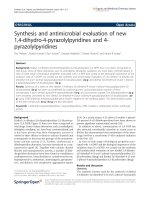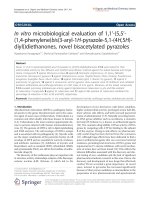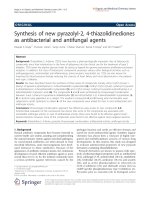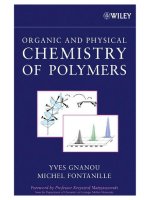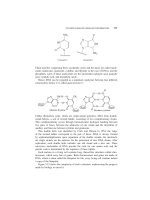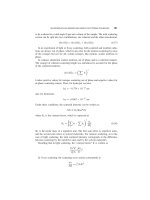fieser - organic experiments 7e [chemistry] (heath, 1992)
Bạn đang xem bản rút gọn của tài liệu. Xem và tải ngay bản đầy đủ của tài liệu tại đây (11.79 MB, 663 trang )
Organic Experiments0
rganic
Experiments
Seventh Edition
Louis
F.
Fieser
Late Professor Emeritus
Harvard University
Kenneth L Williamson
Mount Holyoke College
D.
C.
HEATH
AND
COMPANY
Lexington, Massachusetts Toronto
Address editorial correspondence to:
D.
C. Heath
125 Spring Street
Lexington, MA 02173
Cover: Charlotte Raymond/Science Source/Photo Researchers, Inc.
Copyright © 1992 by D. C. Heath and Company.
Previous editions copyright © 1987, 1983, 1979, 1975, 1968, and 1964 by D. C.
Heath and Company.
All rights reserved. No part of this publication may be reproduced or
transmitted in any form or by any means, electronic or mechanical, including
photocopy, recording, or any information storage or retrieval system, without
permission in writing from the publisher.
Published simultaneously in Canada.
Printed in the United States of America.
International Standard Book Number: 0-669-24344-2
Library of Congress Catalog Number: 91-71287
10 9 8 7 6 5 4
Preface
Organic Experiments, Seventh Edition, presents to the beginning student a
series of clear and concise experiments that encourage accurate observa-
tion and the development of deductive reasoning.
New to this edition is the section at the end of every experiment
entitled "Cleaning Up," which has been written with the intent of focusing
students' attention not just on the desired product from a reaction, but also
on all of the other substances produced in a typical organic reaction.
Throughout the text most, but not all, of the 60 and 90 MHz nmr spectra
have been replaced with 250 MHz proton spectra. A section on 2D nmr is
included in the chapter on nmr spectroscopy, and procedures are given for
the use of chiral nmr shift reagents to determine the optical purity of the
product from the chiral enzymatic reduction of a ketone.
A number of small changes have been made so that Organic Experi-
ments reflects the very latest and best of organic chemistry. Nomenclature
revision is a continuous process. Gradually names such as isoamyl alcohol
are being replaced by their IUPAC equivalents, but slavish adherence to
those rules is not followed; phenol is still phenol (and not benzenol).
As a coauthor of Prudent
Practices
for the Disposal of
Chemicals
from
Laboratories, National Academy of Sciences, Washington, D.C., 1983, I
have continued to follow closely the rapidly evolving regulatory climate and
changes in laboratory safety rules and regulations. The safety information in
this text is as current as it can be, but this is a rapidly changing area of
chemistry; local rules and regulations must be known and adhered to.
Range of Experiments
Organic Experiments includes a wide range of experiments and experimen-
tal procedures:
Pelletized Norit is introduced (Chapter 3). It is easily handled and the
progress of decolorization is easily followed.
Several polymers can be synthesized (Chapter 67), enzymes are used
to carry out chiral reduction of a ketone (Chapter 64), and a unique
synthesis of ferrocene is presented (Chapter 29).
Many of the experiments are classics introduced by Louis Fieser, for
example, the isolation of cholesterol from human gallstones, the use of very
high boiling solvents to speed syntheses of such compounds as
tetraphenylcyclopentadiene and /?-terphenyl, and the Martius Yellow ex-
periment (Chapter 61).
VI Preface
The Whole Experiment—Disposing of Hazardous Waste
A unique feature of this text is an attempt to focus the student's attention on
all materials produced in the experiment, not just the desired "product."
One can no longer flush down the drain or place in the waste basket the
unwanted materials at the end of an experiment. Now these materials must
be disposed of in an environmentally sound manner; often they must be sent
to a secure landfill at great expense.
In this text, students are given specific instructions regarding "Clean-
ing Up" all of the by-products from each experiment. They learn how to
convert potentially hazardous waste to material that in many cases can be
flushed down the drain. They learn how to reduce the volume of toxic
materials in order to cut drastically the costs of disposal. Students must now
come to grips with the same problems that confront industry and govern-
ment.
Cleaning Up The law states that an unwanted by-product from a reaction
is not a waste until the chemist declares it a waste. And once declared a
waste, the material cannot be treated further except by a licensed waste
treatment facility. So, for example, if all of the dilute dichromate waste from
a laboratory were collected together, it could not be reduced chemically or
reduced in volume before being carefully packed and trucked away by a
hazardous waste disposal company. But if each student, as a part of the
experiment, reduces the Cr
6+
to Cr
3+
and precipitates it as the hydroxide,
the total volume of hazardous waste becomes extremely small and thus can
be cheaply disposed of. Throughout this text, procedures based on the best,
current practice, are given for the conversion of hazardous by-products to
less hazardous ones.
My own experience in dealing with hazardous wastes dates back to
1982,
when I sat on the National Academy of Sciences Committee on Haz-
ardous Substances in the Laboratory. This group met every three months
over a two-year period and summarized its findings in Prudent
Practices
for
the Disposal of Chemicals from Laboratories. This book is considered an
authoritative reference on the disposal of laboratory waste, and many of its
procedures are included in this text.
In addition, the whole experimental approach and each "Cleaning
Up"
section has been reviewed by Blaine C. McKusick, retired assistant
director of the Haskell Laboratory, the safety laboratory of E. I. du Pont de
Nemours & Company. Dr. McKusick is also a coauthor of Prudent
Practices.
Acknowledgments
I would like to acknowledge the help of many classes of Chemistry 302
students at Mount Holyoke in developing and refining the experiments in
this text.
Organic Experiments
and
Waste Disposal
vii
For her typing skills, preparation of the index, and organization of the
Instructor's Guide, and for her marvelous tolerance of the writing process, I
thank my wife Louise. I am appreciative of the efforts of the entire staff of
D.C. Heath.
I am indebted to Blaine C. McKusick, retired assistant director of the
Haskell Laboratory of DuPont, who reviewed the overall approach taken
toward hazardous laboratory waste and the "Cleaning Up" procedures
found at the end of each experiment.
Kenneth L. Williamson
Experiments
ana Waste Disposal
An unusual feature of this book is the advice at the end of each experiment on
how to dispose of its chemical waste. Waste disposal thus becomes part of
the experiment, which is not considered finished until the waste products are
appropriately taken care of. This is a valuable addition to the book for several
reasons.
Although chemical waste from laboratories is less than 0.1% of that
generated in the United States, its disposal is nevertheless subject to many of
the same federal, state, and local regulations as chemical waste from indus-
try. Accordingly, there are both strong ethical and legal reasons for proper
disposal of laboratory wastes. These reasons are backed up by a financial
concern, as the cost of waste disposal can become a significant part of the
cost of operating a laboratory.
There is yet another reason to include instructions for waste disposal in
a teaching laboratory. Students will some day be among those conducting
and regulating waste disposal operations and voting on appropriations for
them. Learning the principles and methods of sound waste disposal early in
their careers will benefit them and society later.
The basics of waste disposal are easy to grasp. Some innocuous water-
soluble wastes are flushed down the drain with a large proportion of water.
Common inorganic acids and bases are neutralized and flushed down the
drain. Containers are provided for several classes of solvents, for example,
combustible solvents and halogenated solvents. (The containers are subse-
quently removed for suitable disposal by licensed waste handlers.) Some
toxic substances can be oxidized or reduced to innocuous substances that
can then be flushed down the drain; for example, hydrazines, mercaptans,
and inorganic cyanides can be thus oxidized by sodium hypochlorite solu-
tion, widely available as "household bleach." Dilute solutions of highly
toxic cations are expensive to dispose of because of their bulk; precipitation
of the cation by a suitable reagent followed by its separation greatly reduces
its bulk and cost. These and many other procedures can be found through-
out this book.
Chemists often provide great detail in their directions for preparing
chemicals so that the synthesis can be repeated, but they seldom say much
about how to dispose of the hazardous by-products. Yet the proper disposal
of a chemical's by-products is as important as its proper preparation. Dr.
Williamson sets a good example by providing explicit directions for such
disposal.
Blaine C. McKusick
ix
Introduction
2
3
4
5
6
7
8
9
Laboratory Safety and Waste Disposal 13
Crystallization
27
Melting Points and Boiling Points
45
Distillation 59
Steam Distillation
71
Vacuum Distillation and Sublimation 83
Extraction: Isolation of Caffeine from Tea and Cola Syrup
99
Thin-Layer Chromatography: Analysis of
Analgesics
and Isolation
of Lycopene from Tomato Paste 117
10 Column Chromatography: Acetyl Ferrocene, Cholesteryl Acetate,
and Fluorenone 133
11 Alkenes from Alcohols: Cyclohexene from Cyclohexanol 143
12 Alkenes from Alcohols: Analysis of a Mixture by Cas
Chromatography 149
XI
XII Contents
13 Alkanes and Alkenes: Radical Initiated Chlorination of
1-Chlorobutane 157
14 Nudeophiiic Substitution Reactions of Alkyl Haiides 169
15 The S
N
2 Reaction: 1-Bromobutane 177
16 Liquid Chromatography 183
17 Separation and Purification of the Components of an Analgesic
Tablet: Aspirin, Caffeine, and Acetaminophen 189
18
Biosynthesis
of Ethanol 195
19 Infrared Spectroscopy 203
20 Nuclear Magnetic Resonance Spectroscopy 217
21 Ultraviolet Spectroscopy 235
22 Cholesterol from Human Gallstones 243
23 Bromination and Denomination: Purification of
Cholesterol 247
24 Puiegone from Citroneiioi: Oxidation with Pyridinium
Chlorochromate 253
25 Oxidation: Cyclohexanol to Cyclohexanone; Cyclohexanone to
AdipicAcid 261
26 Acetylsalicylic Acid (Aspirin) 269
Contents
X//7
27 Esterification 275
28 Diels-Alder Reaction 283
29 Ferrocene, Bis(cyclopentadienyl)iron 295
30 Aldehydes and Ketones 301
31 Crignard
Synthesis
of Triphenylmethanol and Benzoic
Acid 319
32 Reactions of Triphenylmethyl Carbocation, Carbanion, and
Radical 329
33 Dibenzalacetone by the Aldol Condensation 333
34 Wittig-Horner Reaction 343
35 p-Terphenyl by the Diets-Alder Reaction 347
36 Nitration of Methyl Benzoate 351
37 Friedei'Crafts Alkylation of Benzene and Dimethoxybenzene;
Host-
Guest Chemistry 355
38 Friedei'Crafts Acylation of
Ferrocene:
Acetylferrocene 363
39 Alkylation of Mesitylene 365
40 Amines 371
41 Sulfanilamide from Nitrobenzene 381
XIV Contents
42 The Sandmeyer Reaction: 4-Chlorotoluene and
2-lodobenzoic Acid 393
43 Malonic Ester
Synthesis:
Synthesis of a Barbiturate 401
44 Photochemistry: The
Synthesis
of Benzopinacol 407
45 Luminol: Synthesis of a Chemiluminescent Substance 415
46 Tetraphenylcyclopentadienone 419
47 Hexaphenylbenzene and Dimethyl Tetraphenylphthalate 421
48 1,2,3,4-Tetraphenylnaphthalene via Benzyne 425
49 Triptycene via Benzyne 431
50 Oxidative Coupling of
Alkynes:
2,7-Dimethyl'3,S-
octadiyn-2,7-aiol 4 35
51 Sugars 439
52 Synthesis of Vitamin K
7
: Quinones 449
53 The Friedel-Crafts Reaction: Anthraquinone and
Anthracene 457
Derivatives of 1,2-Diphenylethane—A Multistep
Synthesis 464
54 The Benzoin Condensation: Cyanide Ion and Thiamine
Catalyzed 467
Contents XV
55 Nitric Acid Oxidation. Preparation of Benzil from Benzoin.
Synthesis of a Heterocycle: Diphenylquinoxaline 471
56 Borohydride Reduction of a Ketone: Hydrobenzoin from
Benzil 475
57 1,4-Addition: Reductive Acetylation of Benzil 479
58 Synthesis of an Alkyne from an Alkene. Bromination and
Dehydrobromination: Stilbene and Diphenylacetylene 483
59 The Perkin Reaction: Synthesis of a-Phenylcinnamic
Acid 489
60 Decarboxylation: Synthesis of
cis-Stilbene
493
61 Marti us Yellow 497
62 Catalytic Hydrogenation 505
63 Dichlorocarbene 509
64 Enzymatic Reduction: A Chiral Alcohol from a Ketone 577
65 Enzymatic Resolution of oi-Alanine 523
66 Dyes and Dyeing 529
67 Polymers 545
68 Epoxidation of Cholesterol 557
XVI Contents
69 Class Blowing 561
70 Qualitative Organic Analysis 569
71 Isolation of Lycopene and ^-Carotene 605
72 Oleic Acid from Olive Oil 609
73 Reaction Kinetics: Williamson Ether
Synthesis
617
74 Searching the Chemical Literature 623
Index 631
CHAPTER
1
Introduction
Prelab Exercise: Study the glassware diagrams and be prepared to identify the
fractionating column, Claisen distilling head, ordinary distilling head, vacuum
adapter, simple bent adapter, calcium chloride tube, Hirsch funnel, and Biichner
funnel.
Synthesis and structure
determination
Effect of temperature
"Working up the reaction"
Synthesis and structure determination are two major concerns of the
organic chemist, and both are dealt with in this book. The rational synthesis
of an organic compound, whether it involves the transformation of one
functional group into another or a carbon-carbon bond forming reaction,
starts with a reaction.
Organic reactions usually take place in the liquid phase and are
homogeneous, in that the reactants are all in one phase. The reactants can
be solids and/or liquids dissolved in an appropriate solvent to mediate the
reaction. Some reactions are heterogeneous—that is, one of the reactants
is in the solid phase—and thus require stirring or shaking to bring the
reactants in contact with one another. A few heterogeneous reactions
involve the reaction of a gas, such as oxygen, carbon dioxide, or hydrogen,
with material in solution. Examples of all of these will be found among the
experiments in this book.
In an exothermic organic reaction, simply mixing the reactants will
produce the products; the reaction evolves heat. If it is highly exothermic,
one reactant is added slowly to the other and heat is removed by external
cooling. Most organic reactions are, however, mildly endothermic, which
means the reaction mixture must be heated to increase the rate of the
reaction. A very useful rule of thumb is that the rate of
an
organic reaction
doubles with a
10°C
rise of temperature. The late Louis Fieser, an outstand-
ing organic chemist and professor at Harvard University, introduced the
idea of changing the traditional solvents of many reactions to high-boiling
solvents in order to reduce reaction times. Throughout this book we will use
solvents such as triethylene glycol, with a boiling point (bp) of 290°C, to
replace ethanol (bp 78°C) and triethylene glycol dimethyl ether (bp 222°C)
to replace dimethoxyethane (bp 85°C). The use of these high-boiling sol-
vents can greatly increase the rates of many reactions.
Running an organic reaction is usually the easiest part of a synthesis.
The challenge comes in isolating and purifying the product from the
reaction because organic reactions seldom give quantitative yields of one
pure substance.
In some cases the solvent and concentrations of reactants are chosen
so that, after the reaction mixture has been cooled, the product will
crystallize. It is then collected by filtration and the crystals are washed with
7
Organic Experiments
an appropriate solvent. If sufficiently pure at that point, the product is dried
and collected; otherwise, it is purified by the process of recrystallization or,
less commonly, by sublimation.
If the product of reaction does not crystallize from the reaction
mixture, it is often isolated by the process of extraction. This involves
adding a solvent to the reaction mixture that will dissolve the product and
will be immiscible with the solvent used in the reaction. Shaking the mixture
will cause the product to dissolve in the extracting solvent, after which the
two layers of liquid are separated and the product isolated from the
extraction solvent.
If the product is a liquid, it is isolated by distillation, usually after
extraction. Occasionally the product can be isolated by the process of
steam distillation from the reaction mixture.
The apparatus used for these operations is relatively simple. Reactions
are carried out in a round-bottomed flask (Fig. 1). The reactants are
dissolved in an appropriate solvent and, depending on the reaction, heated
or cooled as the reaction proceeds.
The flask is heated with a heating mantle or an electric^^A: heater or a
sand bath on a hot plate. The flask is connected via a standard-taper ground
glass joint to a water-cooled reflux condenser. The high heat capacity of
water makes it possible to remove the large amount of heat put into the
larger volume of refluxing vapor (Fig. 1). If the product of a reaction
crystallizes from the reaction mixture on cooling, it is isolated by filtration.
Crystals are grown in Erlenmeyer flasks (Fig. 2) and removed, if the
quantity is small, by filtration on the Hirsch funnel (Fig. 3). A modern
FIG.
1 Reflux apparatus for
larger reactions. Liquid boils in
flask and condenses on cold
inner surface of water-cooled
condenser.
FIG.
2 Erlenmeyer flask with
approximate volume
graduations.
Chapter 1 Introduction
Hirsch funnel fits into the filterflask with no adapter, and is equipped with a
polyethylene frit for removal of the crystals (Fig. 4). For larger quantities of
material, porcelain or plastic Buchner funnels are used with pieces of filter
paper that fit the bottom of the funnel. A filter adapter is used to form a
vacuum tight seal between the flask and the funnel (Fig. 5).
Occasionally a solid can be purified by the process of sublimation. The
solid is heated, usually under vacuum, and the vapor of the solid condenses
<c -^> Filter paper
" Polyethylene filter disk
FIG.
3 Hirsch funnel with
polyethylene frit.
Polypropylene
Hirsch funnel
FIG.
4 Hirsch funnel with
integral adapter, polyethylene
frit, and 25~mL filter flask.
- Filter paper
- Polyethylene filter disk
(frit)
Hirsch funnel
Buchner
funnel
Filtervac
FIG.
5 Suction filter assembly.
Filter flask
Organic Experiments
FIG.
7 Chromatography
column consisting of funnel,
tube,
base fitted with
polyethylene frit, and Leur valve.
To
vacuum
Sublimate
15-mL Centrifuge
"tube, to be filled
with ice
Adapter (Pluro stopper)
Aluminum foil cone
25-mL Filter flask
Material to
be sublimed
Heat source
FIG.
6 Small-scale sublimation apparatus.
on a cold surface to form crystals in an apparatus constructed from a
centrifuge tube fitted with a rubber adapter (a Pluro stopper) and pushed
into a filter flask (Fig. 6). Caffeine can be purified in this manner. This is
primarily a small-scale technique, although sublimers holding several
grams of solid are available.
Mixtures of solids and occasionally of liquids can be separated and
purified by column chromatography. A small chromatography column is
shown in Fig. 7. Larger columns are often made from burettes.
Sometimes the product of a reaction will not crystallize. It may be a
liquid, it may be a mixture of compounds, or it may be too soluble in the
solvent being used. In this case an immiscible solvent is added, the two
layers are shaken to effect extraction, and after the layers separate one
layer is removed.
A separatory funnel is used to effect this process (Fig. 8). The mixture
can be shaken in the funnel and then the lower layer removed through the
stopcock after the stopper is removed. These funnels are available in sizes
from 10 to 5000 mL.
Some of the compounds to be synthesized in these experiments are
liquids. On a very small scale, the best way to separate and purify a mixture
of liquids is by gas chromatography, but this technique is limited to less
than 100 mg of material on the usual gas chromatograph. For larger
quantities of material distillation is used. For this purpose distilling flasks
Chapter 1 Introduction
are used. These flasks have a large surface area to allow sufficient heat input
to cause the liquid to vaporize rapidly so that it can be distilled and then
condensed for collection in a receiver. The apparatus consists of a distilling
flask, a distillation
head,
&
thermometer adapter, a thermometer, a water-
cooled condenser, and a distilling adapter (Fig. 9). Fractional distillation is
carried out using a small packed fractionating column [Fig. 10(f)]. The
usual scale for distillation is about 25 mL. The individual components for
distillation are shown in Fig. 10.
Some liquids with a relatively high vapor pressure can be isolated and
purified by steam distillation, a process in which the organic compound
codistills with water at a temperature below the boiling point of water. The
apparatus for this process are shown in the chapter on steam distillation.
Other apparatus commonly used in the organic laboratory are shown in
Fig. 11.
Distillation
head
Clamp
Condenser
FIG.
8 Separatory funnel with
Teflon stopcock.
Keck clamp
Adapter
Graduated
cylinder
FIG.
9 Apparatus for simple distillation.
Organic Experiments
FIG.
10 Standard taper
ground glass apparatus (14/20
or 19/22). Round-bottomed
flasks of (a) 250, (b) 100, (c) 50,
and (d) 25 mL capacity;
(e) condenser; (f) distilling
column; (g) simple bent
adapter; (h) Claisen distilling
head;
(i) stopper; (j) distilling
head;
and (k) vacuum adapter.
CAUTION: Notify your
instructor immediately if
you break a thermometer.
Mercury is very toxic.
Check In
Your first duty will be to check in to your assigned desk. The identity of
much of the apparatus should already be apparent from the above outline of
the experimental processes used in the organic laboratory.
Check to see that your thermometer reads about 22-25°C (20°C =
68°F),
normal room temperature. Examine the mercury column to see if the
thread is broken—i.e., that the mercury column is continuous from the bulb
up.
Replace any flasks that have star-shaped cracks. Remember that
apparatus with graduations and porcelain apparatus are expensive. Erlen-
meyer flasks, beakers, and test tubes are, by comparison, fairly cheap.
Chapter 1 Introduction
Clean apparatus
immediately
Wash acetone goes in the
organic solvents waste
container
Washing and Drying Laboratory Equipment
Considerable time can be saved by cleaning each piece of equipment soon
after use, for you will know at that point what contaminant is present and be
able to select the proper method for removal. A residue is easier to remove
before it has dried and hardened. A small amount of organic residue usually
can be dissolved with a few milliliters of an appropriate organic solvent.
Acetone (bp 56.1°C) has great solvent power and is often effective, but it is
extremely flammable and somewhat expensive. Because it is miscible with
water and vaporizes readily, it is easy to remove from the vessel. Cleaning
after an operation often can be carried out while another experiment is in
process.
A polyethylene bottle [Fig. 11(1)] is a convenient wash bottle for
acetone. The name, symbol, or formula of a solvent can be written on a
bottle with a magic marker or wax pencil. For crystallizations, extractions,
and quick cleaning of apparatus, it is convenient to have a bottle for each
frequently used solvent—95% ethanol, ligroin, dichloromethane, and di-
ethyl ether. A pinhole opposite the spout, which is covered with the finger in
use,
will prevent the spout from dribbling the solvent.
Pasteur pipettes are very useful for transferring small quantities of
liquid, adding reagents dropwise, and carrying out crystallizations. Surpris-
ingly, the acetone used to wash out a dirty Pasteur pipette usually costs
more than the pipette
itself.
Discard used Pasteur pipettes in the special
container for waste glass.
Sometimes a flask will not be clean after a washing with detergent and
acetone. At that point try an abrasive household cleaner.
To dry a piece of apparatus rapidly, rinse with a few millimeters of
acetone and invert over a beaker to drain. Do not use compressed air, which
contains droplets of oil, water, and particles of rust. Instead draw a slow
stream of air through the apparatus using the suction of your water
aspirator.
Insertion of a glass tube into a rubber connector or adapter or hose is
easy if the glass is lubricated with a very small drop of glycerol. Grasp the
tube very close to the end to be inserted; if it is grasped at a distance,
especially at the bend, the pressure applied for insertion may break the tube
and result in a serious cut.
If a glass tube or thermometer should become stuck to a rubber
connector, it can be removed by painting on glycerol and forcing the
pointed tip of an 18-cm spatula between the rubber and glass. Another
method is to select a cork borer that fits snugly over the glass tube, moisten
it with glycerol, and slowly work it through the connector. When the stuck
object is valuable, such as a thermometer, the best policy is to cut the
rubber with a sharp knife.
Heat Source
A 10°C rise in temperature will approximately double the rate of an organic
reaction. The processes of distillation, sublimation, and crystallization all
8 Organic Experiments
n
1T3
(b)
3T5
-
Disposable
plastic
syringe
—
Rubber sleeve
—Pasteur
pipette
(f)
(d)
(g)
(h)
(e)
(c)
(a)
FIG.
11
Miscellaneous apparatus,
(a) 1~mL
graduated pipette, calibrated
in
1/1OOths
of a mL; (b)
septum;
(c)
1.0~mL
syringe;
(d)
calibrated Pasteur pipette;
(e)
pipette pump;
(f)
glass scorer;
(g)
Filtervac;
(h) set of
neoprene adapters;
(i)
Hirsch funnel with perforated plate
in
place;
(j)
thermometer adapter;
(k)
powder funnel;
Chapter 1 Introduction
(i)
(i)
(k)
Pinhole -
(1)
(q)
(P)
(I) polyethylene wash bottle; (m) single-pan electronic balance with automatic zeroing and digital readout, 100 g
± 0.001 g capacity; (n) electric flask heater; (o) solid-state control for electric flask heater; (p) stainless steel spatula;
(q) Keck clamp.
![fieser - organic experiments 7e [chemistry] (heath, 1992)](https://media.store123doc.com/images/document/14/ne/vz/medium_vzc1401870346.jpg)
